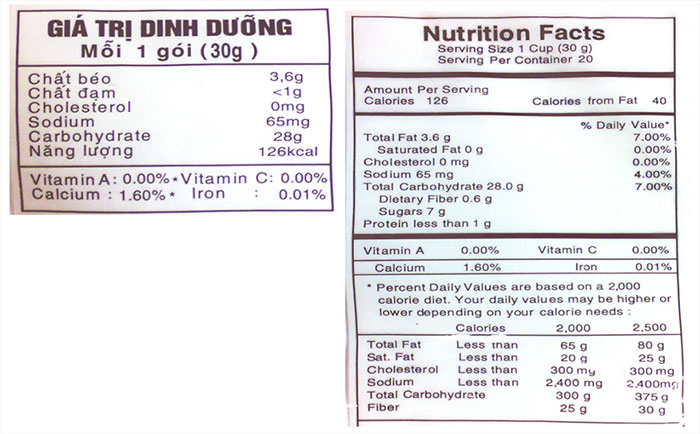Are the nutritional facts on food packaging trustworthy?
If you've ever wanted to know exactly what's in your packaged food, you're probably familiar with the black-and-white nutrition charts on food labels. These charts provide data on calories, protein, fat, and other nutrients. But have you ever wondered how these numbers are measured?
Foods are classified into three main macronutrients : protein, fat, and carbohydrates. These are the basic components the body needs, and each is measured in a separate way.

Nutrition facts table on 1 package.
Protein is measured based on the amount of nitrogen , because protein contains nitrogen, while other nutrients do not. The nitrogen content is multiplied by a factor of 6.25 (because protein usually contains about 16% nitrogen) to determine the protein content. The two main methods for measuring nitrogen are the Kjeldahl method and the Dumas method , where the Kjeldahl method is based on analyzing the amount of ammonia released from a food sample.
Fat is determined by its solubility in organic solvents such as ether or chloroform. The difference in weight of the food sample before and after treatment with this solvent is the amount of fat.
However, this method is time-consuming and can be less accurate, so more advanced techniques such as nuclear magnetic resonance and ultrasound are increasingly becoming alternatives, albeit at higher costs.
Carbohydrates are the body's main source of energy - usually measured indirectly by subtracting the weight of other substances such as protein, fat, water, ash and alcohol from the total weight of the food.
Finally, to calculate calories , a traditional method is to use a bomb calorimeter, where food is burned and the change in water temperature gives a reading of the calories. However, this method is now less used because it is expensive and can give inaccurate results. Instead, the Atwater system is preferred, which calculates the calories from each energy-containing nutrient.
Many people ask, can we trust manufacturers not to exaggerate the nutrients in their products?
There is not much scientific evidence for this , but today we have more accurate methods to calculate nutritional composition as well as convenient online databases and nutritional analysis services to give consumers more peace of mind.
- Introducing food bags can be self-destruct and cook
- Warning: Food packaging contains more than 175 dangerous chemicals
- New-style packaging helps preserve food better than plastic wrap
- Study Shows Risk of Carcinogens in Food Packaging
- Food packaging anti-mold
- Eating science based on recommended nutritional needs
- 10 interesting facts about astronauts' food
- After many years, astronauts are about to eat noodles
- Carcinogenic bottles and packaging?
- Can some food packaging cause infertility?
- Packaging can be used long term?
- Using cornstarch to produce self-destruct packaging
 Soaking vegetables in salt water does not remove chemicals but you should still do it
Soaking vegetables in salt water does not remove chemicals but you should still do it You should limit bamboo shoots if you have 1 in 5 of these diseases
You should limit bamboo shoots if you have 1 in 5 of these diseases Mistakes when soaking vegetables in salt water
Mistakes when soaking vegetables in salt water Risk of death when combining shrimp with vitamin C
Risk of death when combining shrimp with vitamin C